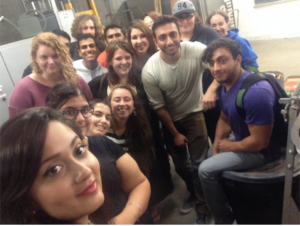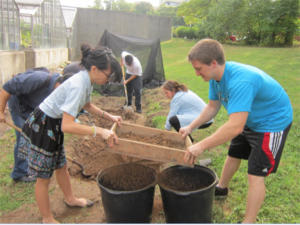During my first semester with the Sustainability Studies Earthworm Ecotoxicology lab, back in January 2012, I had seven brave students working with me. We wanted to examine the effect of acid rain on earthworm health, so we designed and ran the research—and made a lot of mistakes. Some of them were pretty funny. As a primate behavioral ecologist, I didn’t know a lot about earthworms. Who knew that earthworms wouldn’t stay in the containers you put them in? Who knew that fungus gnats from earthworm soils could take over a greenhouse? Well, we know those things now!
With more than thirty students working in the lab each semester, we’ve conducted handfuls of important research. We’ve looked at the effects of substances like fertilizer, Ortho Weed B Gon and Roundup on earthworm health. We’ve submitted a total of six posters to URECA. We’ve helped one student conduct her research for the Honors College, and we’ve participated in the Earthstock Keynote address.
The earthworm students work in groups, run by team leaders. They come to me with ideas, we work though the logistics and hone their hypotheses, and then those students organize the manual labor, data collection and write up. In keeping with that spirit, my current group of students, who are divided into two smaller sub-groups, describe their current research below:
The Cadmium Project
The goal of our experiment is to determine how long it will take to breed cadmium-resistant earthworms. We predict that it will take more than 4 months for the cadmium resistant earthworm to sustain a fertility rate that is comparable to those of normal earthworms. Cadmium is a known pollutant that has negative effects on the fertility of earthworms. This substance enters the environment through sewage waste, as well as its use in manures and pesticides. This chemical is known to affect the earthworms by markedly decreasing the amount of cocoons that can be produced by earthworms per reproductive cycle. To test our hypothesis, we are placing earthworms in soil that has had a cadmium solution applied to it in varying amounts. The soil will be tested over a period of 6 months for microbe respiration. Additionally, we will be determining the resulting earthworm mortality and biomass. This experiment has given us the opportunity to raise awareness to others about the potential dangers of using these particular chemicals.
The Roundup Project
At the Life Sciences Greenhouse, we’re testing the effect of Roundup on soil microbial respiration and earthworm mortality, the supervision of Dr. Pochron and with the assistance of Michael Axelrod and John Klumpp. This project is an interdepartmental collaboration between Sustainability, Biology and Chemistry. We want to see if Roundup, a popular household herbicide, affects soil microbial consortium and worm mortality. Since earthworm presence indicates healthy soil activity, we predict Roundup will negatively affect soil microbial respiration and increase worm mortality. Results from this study will help elucidate the effects of anthropogenic herbicide use on soil ecosystems. Working in the lab, we learn to independently conduct experiments through hands-on experience.

Many of the Fall 2014 worm lab students gathered in Stony Brook University’s Life Science Greenhouse.
 By Sharon Pochron, Ph.D.
By Sharon Pochron, Ph.D.
Professor and Earthworm Ecotoxicology Researcher
Sustainability Studies Program


